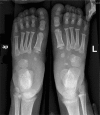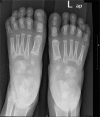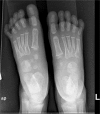Delayed ossification and abnormal development of tarsal bones in idiopathic clubfoot: should it affect bracing protocol when using the Ponseti method?
- PMID: 31312266
- PMCID: PMC6598050
- DOI: 10.1302/1863-2548.13.190080
Delayed ossification and abnormal development of tarsal bones in idiopathic clubfoot: should it affect bracing protocol when using the Ponseti method?
Abstract
Purpose: To point out the need to take into account the dysplastic nature of tarsal bones when treating idiopathic clubfoot (CF).
Methods: Review the published evidence on the developmental abnormalities of tarsal bones in idiopathic CF.
Results: The literature review provides abundant proof of the existence of delayed appearance and slower development of ossification centres of tarsal bones in idiopathic clubfoot.
Conclusion: Gentle manipulations and casting are the cornerstone of the Ponseti method. The biological response of all foot elements is critical for a successful outcome. Delayed ossification and abnormal development of tarsal bones in idiopathic CF may affect the results. Development of a personalized tailored bracing protocol based on severity assessment and response to casting treatment will improve results and quality of care in CF management.
Level of evidence: V.
Keywords: Ponseti; clubfoot; ossification; tarsal abnormalities.
Figures




References
-
- Pirani S, Zeznik L, Hodges D. Magnetic resonance imaging study of the congenital clubfoot treated with the Ponseti method. J Pediatr Orthop 2001;21:719–726. - PubMed
-
- Dobbs MB, Rudzki JR, Purcell DB, et al. . Factors predictive of outcome after use of the Ponseti method for the treatment of idiopathic clubfeet. J Bone Joint Surg [Am] 2004;86-A:22–27. - PubMed
-
- Zionts LE, Ebramzadeh E, Morgan RD, Sangiorgio SN. Sixty years on: Ponseti method for clubfoot treatment produces high satisfaction despite inherent tendency to relapse. J Bone Joint Surg [Am] 2018;100:721–728. - PubMed
-
- Ponseti IV, Smoley EN. Congenital clubfoot: the results of treatment. J Bone Joint Surg [Am] 1963;45-A:261–276.
LinkOut - more resources
Full Text Sources
Research Materials

